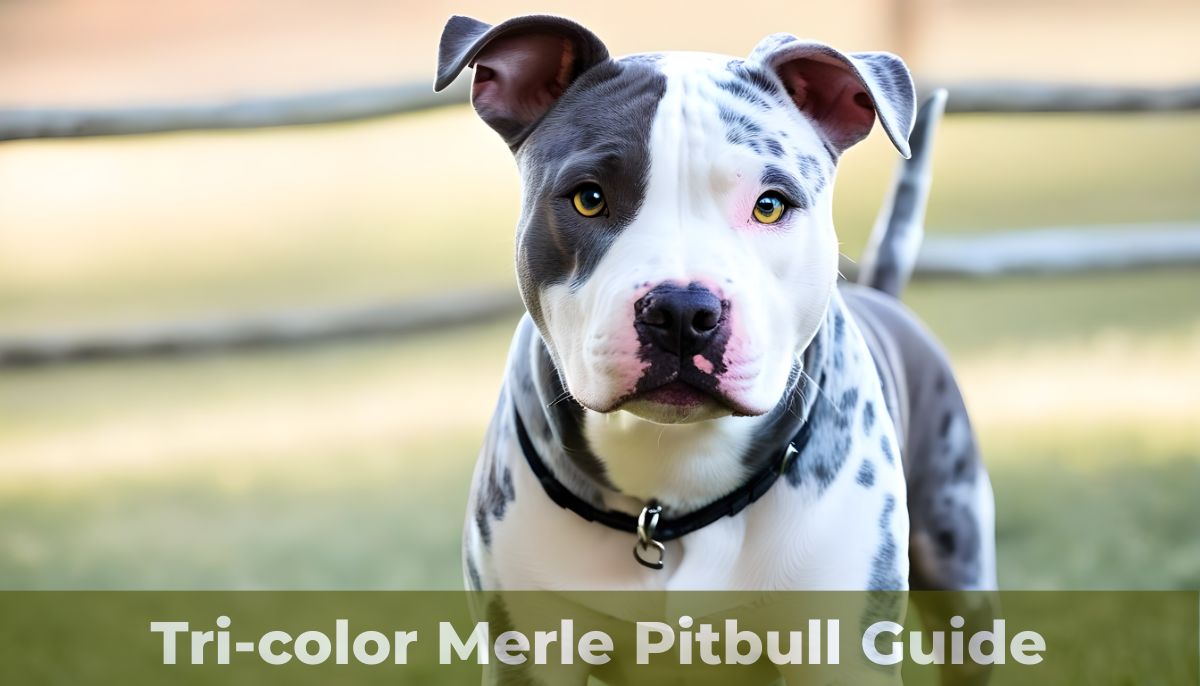“Nature always shows its feelings through colors.” Ralph Waldo Emerson
As Emerson said, imagine dogs like the Tri-Color Merle Pitbull as nature’s colorful creation. These dogs have coats resembling beautiful paintings, mixing different colors to remind us of the fantastic world.
So, let’s go on an adventure to learn more about these special dogs. We’ll uncover the reasons behind their unique fur, explore their friendly personalities, and discover why they’re not just pets but living artworks that bring happiness and color to the lives of the people who welcome them home.
| Appearance | Striking |
| Temperament | Loyal |
| Health | Responsible |
| Adoption | Available |
| Size | Medium to Large |
| Weight | 35-65 pounds |
| Coat Pattern | Tri-color merle, distinctive speckles |
| Exercise Needs | Moderate to High |
| Training | Positive reinforcement |
| Lifespan | 12-16 years |
| Grooming | Low maintenance |
| Socialization | Important for well-behaved pets |
| Origins | American Pit Bull Terrier breed |
What is a Tri-color Merle Pitbull?
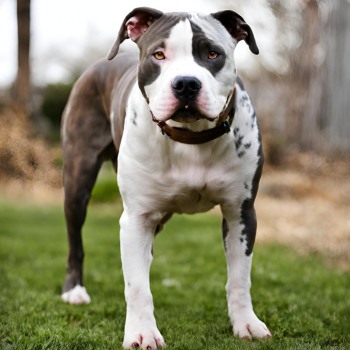
A tri-color merle pitbull is a dog with a distinctive coat pattern caused by a combination of merle gene and the tri-color gene.
They are not a separate breed but a variation within the American Pit Bull Terrier.
In terms of the dog’s name, “Tri-color” refers to the three distinct colors in the coat (blue, brown, and white).
It’s like wearing a coat of three beautiful shades that blend, making them stand out in the dog world.
While “merle” refers to the diluted patches of color caused by the merle gene.
The term “pitbull” is used loosely to refer to a group of dogs that share similar physical characteristics, such as a muscular build and a short, smooth coat.
Decoding Tricolor Merle Coat:
The Tricolor Merle coat is a captivating pattern found in certain dog breeds, characterized by a harmonious blend of three distinct colors: blue, brown, and white.
This pattern is further enhanced by the presence of merle patches, which are diluted areas of color that add depth and dimension to the coat.
The Tricolor Merle coat is not just a physical characteristic; it’s a symbol of diversity and individuality. It’s a reminder that beauty comes in many forms, and embracing our differences enriches the world around us.
Tricolor Merle Pitbulls Genetics:
The merle gene primarily influences the tricolor merle pattern. The Merle gene creates a mottled or blotchy coat pattern by diluting random coat sections to lighter shades.
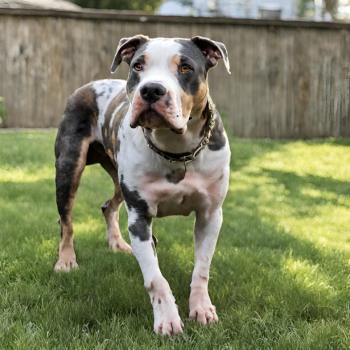
The gene is inherited autosomal dominant, meaning a dog only needs one copy of the merle gene from either parent to express the merle pattern.
- The merle gene primarily affects the distribution and intensity of pigments in the coat, creating the characteristic merle pattern.
- The tri-color gene influences the coat’s base color (black or liver) in areas where the merle gene is not actively suppressing melanin production.
- The interaction between the merle gene and the tri-color gene results in patches of lighter color (due to the merle) interspersed with areas of solid color (determined by the tri-color gene).
Pigment and Eye Color:
In addition to coat color, the merle gene can affect pigmentation in the eyes and nose. Merle Pitbulls often have striking blue or heterochromatic (two different colored) eyes, adding to their overall allure.
The gene can also lead to a mottled or ‘marbled’ appearance on the nose, creating a distinctive feature.
Do Kennel Clubs recognize Merle tricolor Pitbulls?
Pitbulls are not recognized as a breed by major kennel clubs, such as the American Kennel Club (AKC) and the United Kennel Club (UKC).
These kennel clubs have breed standards that define the physical characteristics and temperament of recognized breeds.
Merle Tri-Color Pitbulls do not fit the breed standards of any recognized breed and are, therefore, not officially recognized.
Recognizing a Tri-Pitbull Merle:
Recognizing a Tricolor Pitbull involves noting specific visual traits that set it apart from other Pitbull coat variations.
Identifying physical traits and color patterns:
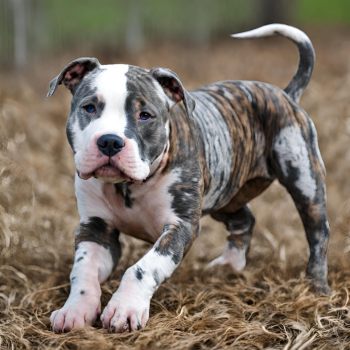
• Coat Color:
Tricolor Merle Pitbulls exhibit a distinctive coat pattern of three primary colors. Look for black, white, and tan patches or combinations like blue, fawn, and white.
• Merle Pattern:
The merle pattern is a defining feature. It creates a mottled or speckled effect on the coat, with areas of lighter color interspersed with solid patches.
• Eye Color:
Many Merle tri-color pitbulls have striking blue or heterochromatic eyes. The Merle gene can influence pigmentation in the eyes, adding to their unique appearance.
• Nose and Paw Pads:
In some cases, the merle gene can also affect pigmentation on the nose and paw pads, resulting in a marbled or mottled appearance.
Differences between tricolor merle & other pitbull coat variations
• Merle vs. Solid Coats:
The most apparent distinction is the Merle pattern. Tricolor Merle Pitbulls have a coat with a mix of solid and diluted patches due to the Merle gene, setting them apart from solid-coated Pitbulls.
• Tri-color vs. Other Coat Colors:
Tri color Merle Pitbulls specifically have three primary colors in their coat. It differs from other coat variations, such as brindle, where stripes of a darker color run over a lighter background.
| Coat Variation | Characteristics |
|---|---|
| Tricolor Merle | Blue, brown, and white with merle patches |
| Brindle | Striped pattern of black, brown, or red |
| Solid | Uniform color of black, brown, red, or blue |
| Piebald | Mixture of patches of different colors |
Size:
Understanding the size attributes of these dogs empowers owners to provide appropriate care, promoting the overall well-being of their dogs.
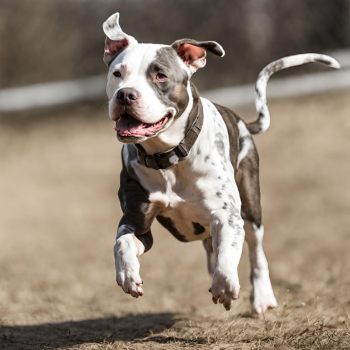
• Average Size:
Like other Pitbull variations, these dogs typically fall within a medium to extensive range.
Adult males generally stand between 18 to 21 inches at the shoulder, while females are slightly smaller, ranging from 17 to 20 inches.
• Weight Range:
The weight of Tri-Merle Pits can vary based on genetics, diet, and overall health. Adult males generally weigh between 35 and 65 pounds, with females ranging from 30 to 50 pounds.
It’s essential to note that variations within these ranges can occur.
• Growth Phases:
Merle Tri Pitties undergo significant growth during the puppy stage. Like many dog breeds, they experience rapid growth in the first six months to a year, and their size continues to develop until they reach maturity, typically around 18 to 24 months.
Energy:
They are typically medium-to-high-energy dogs, requiring ample physical and psychological stimulation opportunities.
Factors Influencing Energy Levels:
Several factors can influence a Tri-Colorl’s energy level:
- Age
- Genetics
- Exercise
- Mental stimulation
Suitable living conditions:
These dogs, being medium-sized dogs, require adequate space to move around comfortably. A house with a fenced-in yard or access to a safe outdoor space is ideal for allowing them to exercise, play, and explore.
If you live in an apartment, ensure it is spacious enough for the dog to move freely and provide regular outdoor exercise.
Exercise needs:
- Daily exercise is crucial for physical health.
- Activities include brisk walks, play sessions, and interactive games.
- Mental stimulation through training and puzzle toys.
- Helps prevent boredom-related behaviors.
- Tailor exercise routines based on age, health, and fitness level.
Grooming:
Tri-Color Merlels have a short, smooth coat that requires minimal grooming. Regular brushing and occasional baths are sufficient to keep their coat healthy and free of dirt and debris.
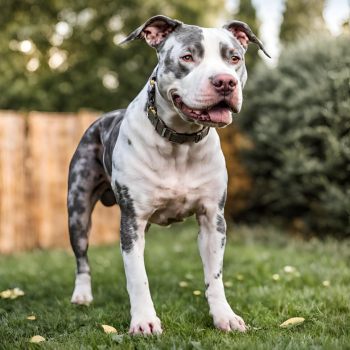
• Regular Brushing:
Brush their coat weekly to remove loose hairs, distribute natural oils, and keep the coat shiny.
• Bathing:
Bathe as needed, usually when they get dirty or develop a doggy odor.
• Tail Care:
Please pay attention to the tail area, ensuring it is clean and free from any signs of infection or irritation.
• Additional Tips:
- After bathing, thoroughly dry your dog’s coat to prevent moisture buildup and skin irritation.
- During shedding seasons, brush your dog more frequently to remove loose hair and avoid matting.
Training and Temperament:
Training and temperament go hand in hand in shaping a dog’s behavior. A positive and consistent training approach is essential for any breed, including Pitbulls and Tricolor Merle individuals.
General characteristics of pitbull temperament
• Affectionate Nature:
Pitbulls are known for their caring and loving nature. They often form strong bonds with their families and can be very loyal.
• Intelligence:
Pitbulls are intelligent dogs, making them trainable and responsive to consistent, positive training methods.
• Energetic and Playful:
Pitbulls are a high-energy breed that enjoys playtime and physical activities. Regular exercise is crucial to keep them happy and healthy.
• Sociable:
Properly socialized Pitbulls can be friendly with other dogs and people.
• Protective Instincts:
Pitbulls may have a natural protective instinct towards their families, making them excellent watchdogs.
Specific Training tips and considerations:
• Positive Reinforcement:
Like all Pitbulls, Tricolor Merle Pit Bulls respond well to positive reinforcement. Reward-based training, using treats and praise, effectively reinforces desired behaviors.
• Consistent Training:
Consistency is vital in training Tricolor Merle Pit Bulls. Establish clear rules and boundaries from a young age and support them consistently.
• Socialization:
Early and ongoing socialization is crucial for Tricolor Merle Pit Bulls. Exposure to various people, environments, and situations helps them develop into well-rounded and confident individuals.
• Mental Stimulation:
Give your dog’s mind a workout with interactive toys and puzzle games. It helps prevent boredom and promotes a healthy mental state.
Dispelling myths about pitbull aggression:
The perception of Pitbulls as aggressive dogs is primarily based on misconceptions and media sensationalism.
• Individual Variability:
Aggression isn’t solely genetic; temperament depends on training, socialization, and environment.
• Nurturing Environment:
Well-trained and nurtured Pitbulls, including Tricolor Merle, can display friendly, non-aggressive behavior.
• No Inherent Aggressiveness:
The idea of Pitbulls being inherently aggressive is baseless. Responsible ownership, training, and socialization shape their temperament.
• Positive Breed Representation:
Dispelling aggression myths is crucial for a positive public view. Many Pitbulls, Tricolor Merle included, are affectionate family pets with proper care.
Health and Care:
Ensuring the health and well-being of your canine companion, be it a Pitbull or a Tricolor Merle individual, involves a holistic approach.
Common health issues in tricolor merle pitbulls:

While tri colored merles are generally healthy dogs, specific health issues may be associated with this coat pattern. These include
• Deafness and Vision Impairment:
Due to the Merle gene, Tri Merle Pitbulls may be prone to congenital deafness or vision impairment, especially if the dog is a double merle. Regular veterinary check-ups can help monitor these conditions.
• Skin Sensitivity:
The Merle gene can influence coat color and skin pigmentation. Some tri-colored merles may have skin sensitivity, making them prone to sunburn. Sunscreen and providing shade during sunny days can help mitigate this risk.
Genetic Health Concerns:
Responsible breeding practices are crucial to minimize genetic health issues. Breeders should avoid mating two merle-coated dogs to reduce the risk of double-merle offspring, which can have increased health vulnerabilities.
Special considerations for Tri pitbulls:
In addition to the general health concerns for all dogs, tri-color merles require some special considerations:
• Avoiding Overexertion:
Tri color Merle Pitbulls may be prone to overexertion due to their energetic nature. Be mindful of their exercise routine, especially in hot weather, to prevent exhaustion and heat-related issues.
• Regular Veterinary Check-ups:
Routine check-ups with a veterinarian are essential for early detection and management of any potential health issues. It is crucial to merge tri color pitbull due to their susceptibility to certain conditions.
• Protecting Eyes and Ears:
Tri-colored merle Pitbulls may have lighter pigmentation in their eyes and ears, so protecting them from harsh sunlight and debris is advisable. It can help prevent irritation and potential health issues.
Tips for maintaining a healthy and happy tri-Pitbull:
Here are some tips for maintaining a healthy and happy Tri color Merle Pitbull:
- Provide a Nutritious Diet: A balanced and nutritious diet is essential for overall health and development. Choose high-quality dog food that meets the specific needs of your dog’s age, activity level, and breed.
- Maintain Proper Hygiene: Regular grooming, including brushing, bathing, and trimming, helps maintain skin and coat health and prevents matting and infections.
- Provide a Loving and Supportive Environment: Tri colored merle Pitbulls thrive in loving and supportive environments. Provide plenty of attention, affection, and positive reinforcement.
Common misconceptions and myths:
Unfortunately, Tricolor Merle Pitbulls are often subject to misconceptions and myths. Here’s a clarification of some common ones:
Misconception 1: Tri-colored merle Pitbulls are Limited Breeding Stock.
Myth: Some may believe Merle Tricolor Pitbulls have limited breeding potential due to their unique coat color.
Fact: However, responsible breeders carefully manage breeding programs to maintain the health and diversity of the breed.
Misconception 2: Tricolor Merles are always deaf or blind.
Myth: The Merle gene is directly linked to deafness and blindness in Tri-Merle Pitbulls.
Fact: While there is an association between the Merle gene and hearing and vision problems, not all Merle Tricolor Pitbulls are affected.
Responsible breeders conduct thorough health screenings to minimize the risk of these issues.
Misconception 3: Tri Pit bulls are not suitable for families.
Myth: Merle tricolor pitbulls are unsuitable for families due to their perceived aggression.
Fact: Tri Merle Pitbulls can make excellent family dogs when raised in responsible and loving environments. Their loyal and protective nature can be a valuable asset to a family.
Tri-Color Merle Pitbull Puppies:
Tri Merle puppies are a delightful mix of the Pitbull breed with a distinctive coat pattern.
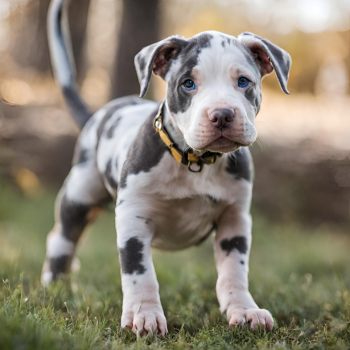
Tri Pitbull pups are not just about their captivating coat pattern but also a testament to the diversity and beauty of canine genetics.
While their appearance is striking, they can also be calm and loyal companions, forming deep bonds with their owners.
Like all Pitbull puppies, Tricolor Merles has substantial exercise needs. Regular play and walks are essential for their physical and mental well-being.
Start training early to establish positive behaviors. Merle Tricolor Pitbull pups respond well to positive reinforcement techniques.
Birth Colors:
When Tri-color Merle Pitbull pups are born, their coats are often a blend of lighter shades, like pale blues, fawns, or diluted blacks.
• Progression Weeks Later:
As weeks pass, the coat’s tricolor pattern becomes more pronounced. Puppies may develop black, white, tan, blue, or fawn patches, forming a visually captivating combination.
The Merle gene actively creates a marbled effect, with lighter areas scattered across the body.
• Unique Coat Variations:
Each Tricolor Merle puppy’s coat is fantastic. Some may have prominent patches of black with subtle fawn highlights, while others may exhibit a striking blend of blue and white.
• Mature Coat:
When Tricolor Merle pups mature, their coat colors settle into a harmonious tricolor blend.
Color Distribution on the Body:
The Merle gene influences the coat, creating patches of lighter color interspersed with solid areas. These patches can appear in various patterns.
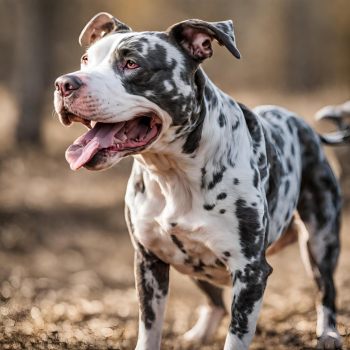
Diverse Patterns in Color Distribution:
Each Tri Merle Pitbull puppy showcases a unique combination of these patterns, creating a visually captivating and individualized coat.
• Speckled or Mottled Pattern:
The coat displays a lively, textured look with lighter patches scattered across the body.
• Harlequin Effect:
Bold and irregularly shaped patches of lighter color contrast sharply against a solid background.
• Brindle Influence:
Some pups may incorporate brindle striping within the patches, adding complexity to the overall pattern.
• Symmetrical Patterns:
Lighter and darker areas mirror each other on either side of the body, enhancing balance and aesthetic appeal.
• Unique Markings:
Individual puppies may have distinct facial spots or swirls of color, contributing to their one-of-a-kind appearance.
Tri Color Merle Pitbull Price:
Tri-Merle Pitbull prices vary widely. On average, prices may range from a few hundred to several thousand dollars, depending on the factors.
TriColor Merle pups can range from $500 to $5,000 or more. However, it’s important to emphasize that price is not the sole determinant of a puppy’s value.
Responsible breeders focus on raising healthy, well-adjusted companions, not just producing puppies with a specific coat pattern.
Be cautious of unusually low prices, which may indicate substandard breeding practices or health issues.
It’s essential to choose a breeder based on reputation, ethical practices, and the overall well-being of the puppies.
Understanding the factors influencing the price of Tri-Color Merle Pits allows potential buyers to make informed decisions, ensuring they receive a healthy and well-cared-for puppy from a reputable breeder.
What is a Blue Tri Merle Pitbull?
A Blue Merle Tri Pitbull is a genetic combination that results in a tricolor coat featuring shades of blue, tan, and white, enhanced by the merle gene’s characteristic mottling or speckling effect.
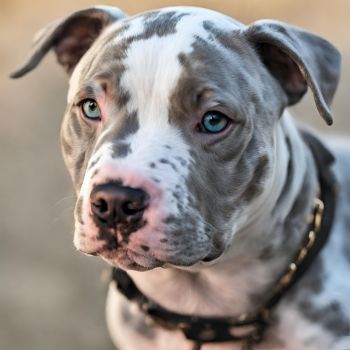
“Blue” in Blue Tri Merle Pitbull refers to a diluted black color, presenting a striking bluish hue.
The blue color in the blue merle tricolor results from a dilution gene affecting the black pigment (eumelanin).
The merle gene introduces a mottled or speckled effect to the coat, further enhancing the visual appeal.
It creates patches of lighter color interspersed with solid areas, adding complexity and individuality to each dog’s appearance.
Both parent dogs must carry the necessary genetic factors to produce Tri Merle Blue offspring.
What is a Tri-Color Blue Nose Pitbull?
A Tri-Color Blue Nose Pitbull is a Pitbull dog with a coat that combines three distinct colors: blue, brown, and white, along with a distinguishing blue nose.
Characteristics of Blue Nose Tri-Color Pits:
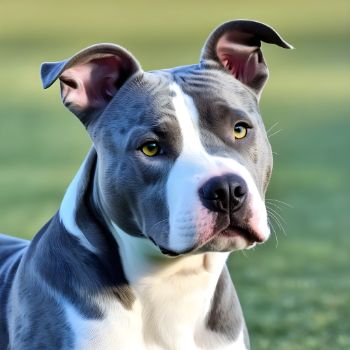
• Coat Color Palette:
These Pitbulls showcase a tricolor palette, typically incorporating shades of blue, tan, and white.
This combination contributes to their distinctive and aesthetically pleasing appearance.
• Blue Nose Trait:
The term “Blue Nose” refers explicitly to the coloration of the dog’s nose. In Tri Blue Nose Pits, the nose is a unique shade of blue, adding to their individuality and charm.
• Genetic Factors:
The coloration of Blue Nose Tricolor Pitbulls is influenced by genetic factors inherited from both parents.
Genetics of Tri-Color Blue Nose Pitbulls:
• Inheritance of Coat Colors:
The tricolor coat is inherited through a combination of genes from the parent dogs. Genes for blue, tan, and white coloration interact to create the unique tri-color pattern.
• Blue Nose Gene:
The blue nose trait is associated with a specific gene that influences pigmentation. Dogs with a blue nose typically inherit this gene, resulting in the distinctive blue coloration of the nose.
• Selective Breeding Practices:
Responsible breeders employ particular breeding practices to enhance and maintain traits, including coat colors and nose pigmentation.
The blue nose results from the recessive dilute gene, which dilutes the black pigment in the dog’s nose, resulting in a greyish-blue hue.
• Genetic Influences:
The Tri-Color Blue Nose Pitbull’s coat pattern is influenced by two primary genetic factors: the merle gene and the tri-color gene.
When present in two copies, the merle gene creates the characteristic merle pattern of diluted patches interspersed with solid-colored patches.
The tri-color gene determines the coat’s black, brown, and white pigment distribution. Due to the dilute gene, the black pigment is diluted to blue in Tri-Color Blue Nose Pitbulls.
Distinguishing Features:
ThesePitbulls are characterized by their:
- Tri-Color Coat Pattern: A combination of blue (diluted black), brown, and white patches, often with a unique mosaic-like distribution.
- Blue Nose: A grayish-blue nose due to the recessive dilute gene.
- Muscular Build: A muscular and athletic build typical of Pitbull dogs.
- Short, Smooth Coat: A short, smooth coat requiring minimal grooming.
Purple Tri color pitbull:
The Purple Tri-Color Pitbull, a captivating variation of the American Bully breed, has gained popularity among dog enthusiasts for its unique coat pattern and gentle temperament.
While not officially recognized as a distinct breed by major kennel clubs, these dogs have garnered a loyal following due to their striking appearance and affectionate nature.
The exact distribution of lilac, brown, and white in a Purple Tri-Color Pitbull’s coat varies among individual dogs, creating a unique mosaic of patterns.
While this coat pattern is visually striking, knowing about potential health concerns associated with the merle gene is essential.
Some Purple Tri-Color Pitbulls may be more prone to deafness and blindness. Responsible breeders prioritize the health of their puppies by conducting thorough health screenings and selecting breeding pairs carefully.
Are tricolored merle Pitbulls a separate breed?
No, tricolor merle Pitbulls are not a separate breed. They are a variation within the American Pit Bull Terrier, showcasing the breed’s diversity in coat patterns.
How is the tri-color merle coat pattern achieved?
The tricolor merle coat pattern results from combining the merle gene and the tricolor gene, producing a visually striking mix of three colors and a distinctive speckled appearance.
Can tricolor merle Pitbulls be good family pets?
Yes, tricolor merle Pitbulls can be excellent family pets. Like any other variety, their behavior is influenced by genetics, upbringing, and training. Proper socialization and positive reinforcement contribute to a well-behaved family companion.
Can I adopt a tri-coloured Merle Pitbull from a rescue or shelter?
Yes, tricolor merle Pitbulls can be found in rescues and shelters. Adoption is a wonderful option, providing a loving home for a needy dog.
Conclusion:
Our journey through Tri-Color Merle Pitbulls reveals them as affectionate companions with unique coat patterns. From their energetic nature to grooming tips, understanding their characteristics fosters responsible ownership.
If you’ve had experiences with these delightful dogs or insights to share, don’t hesitate to comment! Your thoughts enrich our community. Let’s keep this conversation going—share your stories, tips, or questions below!

